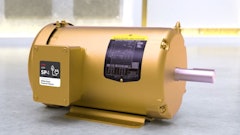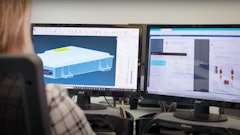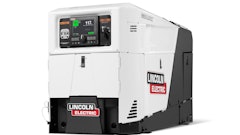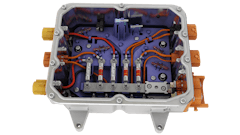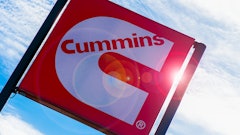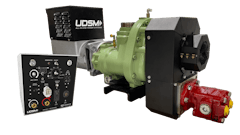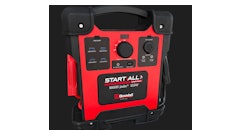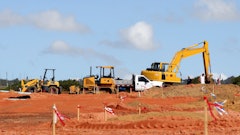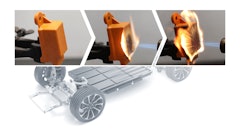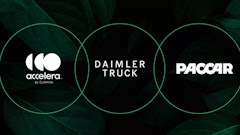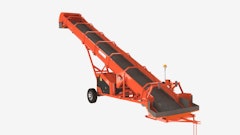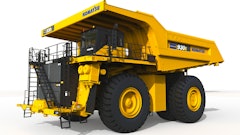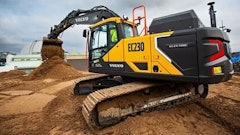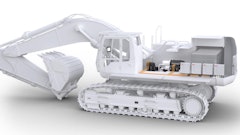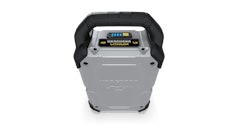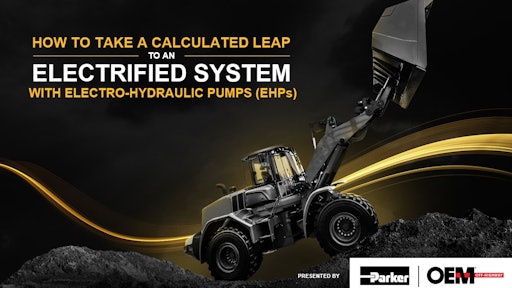
During the March 8, 2023, Parker webinar, “How to Take a Calculated Leap to an Electrified System with Electro-Hydraulic Pumps (EHPs),” the Parker team did not have enough time to answer all the questions. This blog includes the questions and the Parker team’s answers.
With stated electric motor speeds of up to 8,000 rpm, should we expect more pumps coming from Parker that will tolerate that speed?
Parker’s P1M mobile variable piston pump already has industry leading speed capability because of its patented inlet design. We will continue to innovate around speed range and noise reduction across all our pump families, especially as electrification trends intensify.
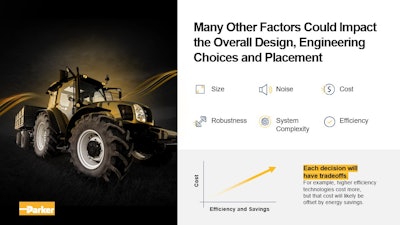 Determine your priorities are when selecting components for electric systemsParker Hannifin
Determine your priorities are when selecting components for electric systemsParker Hannifin
Load sensing systems also contribute to reduce torque requirement resulting in reduced battery power, right?
Yes, we agree. Load sensing systems are in the arsenal of technologies to optimize battery use.
What are your average lead times for Parker electric motors at the moment?
Parker’s global vehicle motor (GVM) product line is currently experiencing longer than hoped for lead times because of continued supply chain constraints and high demand for the product. Current lead times are in the 24-to-26-week range, but expedites are possible, particularly for prototypes depending on the configuration needed. Please contact your local Parker representative.
Does Parker have any variable displacement pumps that can run at 3,000 rpm?
Parker’s P1M 28-cubic-centimeter (cc) and 45-cc variable displacement pumps can already operate at or above 3,000 rpm because of a patented inlet design. Even larger displacement P1M pumps can likely operate at 3,000 rpm with a boosted inlet. Please contact your Parker representative to assist with your application needs.
With e-systems becoming relevant, are you seeing the need or requests for UL-certified products? Does UL certification really apply to electric mobile equipment?
Yes, there have been previous customer requests for UL-certified products and can be a requirement for electric mobile equipment depending on the customer, application and location.
How does Parker combat the reluctance of electric conversion on new products?
We feel a great way to make customers less resistant to converting to an electric system is to minimize the drawbacks compared to an existing ICE system. Parker is working hard to create electrified systems that match the performance and durability of existing ICE expectations. Additionally, highlighting the strengths of an electric system, such as reduction in noise or instant torque provides benefits, may reduce the hesitancy to switch to a new architecture.
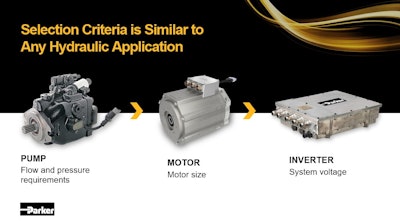 Ask an expert for help when making component selectionsParker Hannifin
Ask an expert for help when making component selectionsParker Hannifin
What is an expected regeneration efficiency with a hydraulic system (lowering a load for example)?
This is tough to give a single answer as the result is system dependent. If you have a specific application, please reach out to Parker for help. A few things to note if you are considering a regeneration system is:
- Select a pump which allows regeneration
- Size and select an inverter that can regenerate electric power back to the battery
- Analyzing the use cycle to determine if regeneration is going to generate a sufficient level of energy where it becomes value-added (perhaps the biggest factor)
Does Parker have variable electrical motors at 700 volts direct current (VDC)?
Parker’s GVMs are rated up to 800 VDC. You can find this and other technical details here.
Are the inverters designed strictly to drive the DC motor, or do they house logic control such as an industrial variable frequency guide?
The Gen 2 global vehicle inverter (GVI) designs are born from our industrial experience, but they are for mobile applications. There is currently no plan to adapt for industrial applications.
How much more complex is a distributed hydraulic pump operating a hydraulic cylinder with or without power regeneration?
From a control logic perspective, there is a significant increase in complexity when considering power regeneration. Performance tuning and battery management must be considered among many other factors. From a hydraulic hardware perspective, no change to moderate change may be required depending on the baseline and desired goals. The pump must be of a type that allows regeneration, valves, such as relief or directional control valves, may need to be changed.
What do you recommend for areas that have little/no access to the electrical grid?
We would recommend possibly a hybrid system (downsized diesel ICE with a smaller battery) and a more efficient hydraulic architecture that leverages variable speed electric motors. Refueling is still easy and fast, but significant efficiency gains can be achieved with ePumps over directly coupled ICE-driven hydraulic pumps.
What is Parker doing to validate ePump offerings from a functional safety perspective?”
ePumps (pump/motor) when driven with GVI Gen 2 (inverter) can support functional safety goals per ISO 26262 and ISO 13849.
Does Parker offer any trainings on working with your inverters?
Parker currently offers training to B sample customers and is working to develop a broader training for product release (SOP). Please contact Parker for additional information.
Are there energy regeneration opportunities with an EHP system?
Yes, we go into more detail and answer this in other questions.
Andy mentioned that running temperatures directly impact efficiencies. Could he elaborate on that? Was he referring to hydraulics or electric motors? Does he have temperature related efficiency maps?
The efficiency of a permanent-magnet, alternate-current motor, such as Parker’s GVM series, will be adversely affected at high operating temperatures. This is why effective cooling is essential to an efficient and long-lasting system. Efficiency graphs in our GVM catalog are at 65°C. Temperature is also included in our efficiency models and simulations discussed during the webinar. Please contact Parker for specific flow and cooling temperature data for your specific applications.
 Electric component selection depends on the application parametersParker Hannifin
Electric component selection depends on the application parametersParker Hannifin
Can you give me contact information to get a system designed to prototype?
Please contact your local Parker representative to help us understand your needs and how we can best assist. The Where to Buy link on parker.com is a great place to begin.







